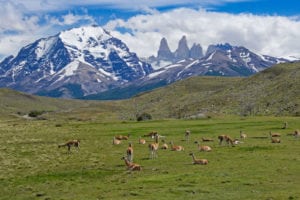It’s impossible to imagine a wilder or more spectacular location than southern Chile’s Torres del Paine National Park. Scenery alternatively described as breathtaking and jaw-dropping and a fierceness no number of visitors can tame, make it a must see on Renedian’s Journey to Ushuaia trip. In fact, we spend two nights in Chile’s landmark park.

Guanacos in Torres del Paine National Park, Patagonia, Chile.
12 Reasons to Visit Torres del Paine National Park
- Three immense granite towers give the park its name; Torres del Paine is Spanish for Towers of Paine. (pronounced “PIE nay”).
- According to the studies of Paleo-Indian artifacts found surrounding the park, the area must have been inhabited 12,000 years ago. The Tehuelche Indians, descendants of the Paleo-Indians named the peaks “Paine”, or “blue” in their language.
- Vividly coloured lakes of piercingly bright teal or milky green, most due to rock flour suspended in their waters, pampas (grassland and steppe), glaciers, valleys, waterfalls, and rushing rivers surround the Torres.
- Strong winds are infamous. November to January are the windiest months—and peak tourist season.
- The meteorological conditions of the park are variable due to the complex topography. Expect to be battered by winds, pelted by rain or sudden snow, or blinded by dazzling sun at any time of day, sometimes all of the above in the course of a few hours.
- Four main glaciers of the Southern Patagonian Ice Field (Dickson, Grey, Zapata, and Tyndall) consume the entire western side of the park. Studies of the park’s glaciers have given scientists a clearer picture of the epochs of the earth, particularly after the last ice age.
- The Paine massif (ridge) an eastern spur of the Andes, rises dramatically above the Patagonian steppe and dominates the landscape.
- Distinctive ecosystems, dramatic landscapes and rare flora and fauna are found nowhere else on the planet.
- In June 2014, melting glaciers exposed rock faces where scientists uncovered fossils of at least forty-six ancient specimens of nearly complete skeletons of dolphin-like creatures which lived between 245 and ninety million years ago.
- More than 3,000 guanaco, close cousin to the llama and endangered only a few decades ago, live here. That’s more than enough to sustain a growing population of pumas. The Patagonian puma is the southernmost mountain lion and one of the largest.
- Swirling thermals of the park’s cliffs, peaks, and valleys create the perfect environment for the Andean condor. A wing span of more than three metres, the largest of any land bird, enables them to stay aloft with minimal effort.
- National Geographic has voted this the fifth most beautiful place in the world. Trip Advisor calls it the eighth wonder of the world.
Resources:

